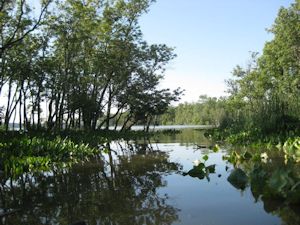The Dyke Marsh Wildlife Preserve is a 485-acre freshwater, tidal wetland complex just south of Alexandria, Virginia, in Fairfax County, Virginia, on the western shoreline of the Potomac River around 95 miles from the Chesapeake Bay. Congress added the preserve to the national park system in 1959 "so that fish and wildlife development and their preservation as wetland wildlife habitat shall be paramount." (Public Law 86-41)
Dyke Marsh is one of the largest, most significant temperate, climax, narrow-leafed cattail marshes in the national park system, a unit of the George Washington Memorial Parkway managed by the National Park Service. It has tidal wetland, swamp forest, upland forest and open water. The southern part of the marsh is at least 2,200 years old.
In the 18th and early 19th century, the marsh was called "Hell Hole Swamp." In the early 1800s, people built earthen walls around the perimeter of part of the marsh to create more "fast land," land not inundated by high tides. The "dyked" area was then used to graze livestock and to grow crops. The walls failed.
From 1940 to 1972, Smoot Sand and Gravel dredged and hauled away almost half of the marsh, destabilizing the entire system. See "The Accelerating Erosion of Dyke Marsh" and our restoration page.

Why Is Dyke Marsh Significant?
FODM has created a fact sheet that explains why Dyke Marsh is significant. It includes some of the rare plants and animals in the marsh.
Today, Dyke Marsh is one of the largest remaining, freshwater, tidal wetlands in the Washington metropolitan area, but the wetlands have diminished to under 50 acres.
Dyke Marsh is home to many species that can only survive in wetlands. Wetlands are by their nature a water-laden environment with an enormous diversity of life forms. Wetlands provide ecological services for free. For example, they mitigate flooding, buffer storms, filter pollutants and provide habitat.
Dyke Marsh is habitat for 300 known species of plants, 6,000 arthropods, 35 mammals, 38 fish, 25 reptiles, 22 amphibians, 84 mollusks, 48 crustaceans and over 294 species of birds, and possibly 20,000 species of insects..
Dyke Marsh, a Well-Studied Marsh
Under the sponsorship of the Friends of Dyke Marsh, ecologist and author David W. Johnston, Ph.D., (1926-2015) consolidated and summarized many studies and reports addressing Dyke Marsh and published a paper in the Virginia Journal of Science (Volume 51, Number 4, Winter 2000). This compilation is an invaluable historical record and source of data about Dyke Marsh’s ecology, flora and fauna and human interaction.
The Virginia Journal of Science has made it available online here. You can access it on our website at Johnston Study. FODM has a limited number of reprints. Email us to determine availability and briefly explain your interest in the document.
Dr. Johnston was a member of FODM’s Board of Directors. He served in the U.S. Navy, earned his Ph.D. from the University of California at Berkeley, taught ornithology and conducted research at Wake Forest University, the University of Virginia and the University of Florida. He was Ecology Director at the National Science Foundation and worked at the National Academy of Sciences. He published widely on ornithology and ecology.

What to See in Dyke Marsh
FODM has produced four seasonal brochures to show you what is possible to see in Dyke Marsh at each time of the year.
Marsh Viewer
These aerial photos of Dyke Marsh are from a Fairfax County imagery viewer and were taken in 1937 (left) and 2021 (right) and show how much of the wetland habitat has disappeared (See our restoration page). To view these photos in a larger format and to learn more about using the imagery viewer, click here.

"On the Edge," a Film about Dyke Marsh
“On the Edge – the Potomac River Dyke Marsh” is a 43-minute video commissioned by the Friends of the Dyke Marsh in 2005 which premiered at the Kennedy Center to a capacity crowd. The video features the biodiversity of Dyke Marsh and many of the people who have been instrumental in preserving it. Dave Eckert was the videographer and producer.


